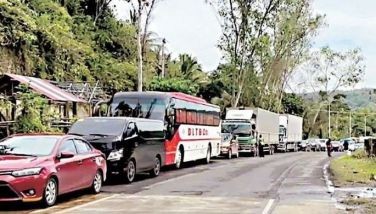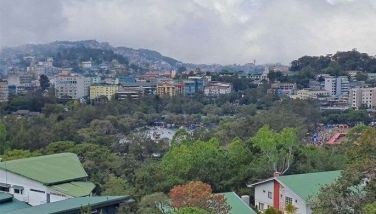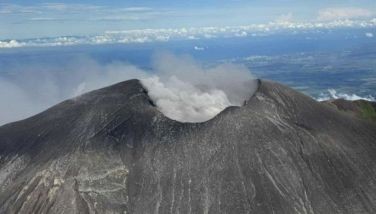Voyage to dangerous ground, the Spratlys

MANILA, Philippines — The Spratly Islands, one of the world’s most hotly contested zones, is around 800 kilometers from Manila (or double the distance to Laoag and half the distance to Davao City). It’s a place so distant that one crosses into a different time zone to get to its furthest tip, the Philippine island of Pag-Asa, that is part of the Kalayaan isles of Palawan in the West Philippine Sea. Ayungin Shoal, where the BRP Sierra Madre is beached in defense of Filipino territory, is halfway to Pag-Asa.
It’s a mind-bending 33-hour trip that embeds you in real-time in the newspaper headlines of the conflicts between the axe-wielding sailors of the China Coast Guard and our steadfast men of the Philippine Navy.
Caught in the middle, and forgotten by most news coverage, are the real-life Filipinos who live and work on Pag-Asa Island – which means ‘Hope’ in Filipino and was also the alias of one of the country’s most beloved heroes, Andres Bonifacio, who used the codename “May Pag-Asa” for himself. Against all odds, and the push and pull of international diplomacy, this valiant little Filipino community continues to live their lives in astonishing normalcy and the spirit of hope for an untroubled life.
On the horizon lurk the outlines of the menacing witnesses to the colorful tapestry that is most beloved of Filipino life, town fiestas and tiny tots at play, beauty queens and cooking contests and moveable feasts. In contrast – like a gigantic spoiler alert – a Chinese armada daily makes their presence felt in the near distance through shadowy naval maneuvers and swarms of military fishing vessels that ram the coral reefs and deplete the waters of its life-giving catch. After sunset, there are other ships so brightly lit that they often eclipse the night stars.
This reportage is from a group of “adventure tourists,” including documentary photographer Paul Quiambao, who recently made the trip to Pag-Asa, sailing from the Palawan port of Bataraza. The journey begins with a six-hour, bone-jarring trip by land from Puerto Princesa, the provincial capital, to catch a lancha (or power-driven launch) named the MB Lady Hadzraima II. It’s a flat-deck vessel with wide windows, carrying 20 men and women who dare visit this uneasy paradise. They are accompanied by 30 tour organizers and boat crew; none of them are armed.
Quiambao is an intrepid traveler who has explored the farthest points of the Philippines, from Mavulis Island, north of Batanes, to Benham Rise, east of Aurora province, and to Pangguan Island, south of Tawi-Tawi. This is basically his story. He is one of a motley crew that includes young backpackers, but also a regional trial court judge with a DOJ prosecutor (husband and wife), a priest and a journalist from The Atlantic, an American political magazine.
For a few thousand pesos, one can join the cruise to the Kalayaan islands, which for the amount paid includes a foldable cot (without pillows), access to clean toilets (but sans shower facilities) and three square meals cooked by an onboard chef (mostly chicken dishes and quite acceptable).
The good weather produces a postcard-perfect sea, says Quiambao, who adds the ‘azure’ gingerly as if it would not be believed but he says that the word is absolutely spot-on. It is breathtakingly blue but they do not spot much marine life, except for the occasional dolphin – an ominous sign that the oceans are slowly but deliberately being emptied out. The sunburnt day quickly turns into a pitch-black night.
Quiambao recalls that the monotonous keening of the ship’s engine makes sleep uncomfortable. He would fall in and out of slumber in the sticky heat until approximately 2 a.m. – or 15 hours into the journey – when the entire group of passengers were awakened by the overpoweringly luminous spotlights of a grey-white vessel trained on them, as sinister as the bright eyes of a monster shark. The words “China Coast Guard” were written out in bold red letters down the side of the ship, the better to make its identity that much more unmistakable. The tour organizers turned visibly nervous, fearing that they may be assaulted by water cannons or worse. The CCG boat would shadow them for a good seven to eight hours until 8 a.m., when it peeled off as mysteriously as it had appeared. Nobody was able to go back to sleep.
Finally, the tour boat reached Pag-Asa which was in the middle of celebrating its Pistang Karagatang Kanluran (the West Philippine Sea Fiesta), a newly-minted milestone. It was just the second year of this five-day event which featured a parade, a fun run and a beauty pageant called “The 1st Misis Kalayaan – I Am the Solution Pageant.” The winners set sail for a victory lap on a wonderfully decorated rig that is covered in tiny pennants and floral garlands. (A CCG patrol spoils the otherwise bucolic shot. Onlookers swear that the military was completely perplexed by the flotilla of beauty queens.) There was also an Araw ng Sining at Kultura (Day of Art and Culture) which included the Pag-Asa Bunkers Restoration and an exuberant Rancuda Runway Dance Challenge on the wide cement highway that runs down the length of the island. People cheered at the Bankarera sa Pag-Asa boat race, an Amazing Race Kalayaan, a Takbo ng Kalayaan, a Laro ng Lahi sports fest and even a cooking contest, the ambitiously titled The Longest Uni-Grilling in the World.
The highlight of each day, however, was the raising of the Philippine flag – and this ritual, otherwise humdrum in the rest of the country, takes on a special meaning in Pag-Asa. It has the sense of the first time the three stars and the sun were first unfurled after General Aguinaldo’s very first victory in Cavite. Every single morning, the appearance of the tricolor is a truly moving experience, said Quiambao. Spurred by the sight, he and his friend Cheenie Landayan would later decide to take a fishing boat out to a nearby sandbar called Sandy Cay I where they pitched a Filipino flag to a bamboo pole and brandished it in the air.
“We were both just curious travelers who wanted to experience what it felt like to wave the Philippine flag in this remote and disputed part of our country. The boatmen reminded us that we could only stay on the sandbar for two minutes before we would be chased away by the China Coast Guard,” reminisced Quiambao. It was a 120-second experience that resonated with fellow Filipinos as the drone video went viral on social media, just in time for the National Flag Days.
Indeed, the China Coast Guard, always watchful, did not let that patriotic gesture go unchallenged, and an iron privateer hoved into view soon after and kept an uncomfortably close distance to the tiny Pinoy banca.
On Pag-Asa Island, the only connection to the outside world is through a WiFi hotspot provided by the Philippine Department of Information and Communications Technology, positioned under a grizzled dankalan tree, which also serves as a center for community activity. News from the capital is exchanged (along with the town gossip). People catch up with their Facebook. There’s an air of bonhomie and comradeship, pierced by moments of quiet and contemplation.
There are only a few hundred residents on the island, all self-taught fishermen, who now worry that they will have to learn a new way of life. The catch from the disputed waters has become alarmingly sparse. “According to our boatmen,” Quiambao sighs, “90 percent of the corals around Pag-Asa island have been destroyed due to these illegal activities. There are some instances that around 50 foreign vessels have swarmed inside the reef to uproot giant clams.” Indeed, Quiambao’s poetic underwater photographs depict only one or two fish in a sea that was once filled with schools of all kinds of marine life. It’s hard to accept that the serene beauty of Pag-Asa is constantly interrupted by the Chinese vessels that parade along the line of the horizon, always visible from every window in the homes across the island.
Quiambao chances upon a barefoot nine-year old girl, called Heart, at the WiFi hub as she watches YouTube. She’s just grade 3. He asks her bluntly, “Natatakot ka ba sa China (Are you afraid of China)?” She answers just as boldly: “Hindi ako natatakot, kasi kapag pinakita kong natatakot ako, mas lalo silang lalakas (I’m not afraid, because if I show I’m afraid, they’ll be stronger).”
“I next asked her what her hope was for Pag-Asa Island. Heart replied simply, ‘Gusto ko po mag bati yung China at Philippines kasi ayaw ko silang magaway, parehas parehas naman silang tao, bakit sila nag aaway (I want China and the Philippines to be friends and not fight, they’re both human beings, why are they fighting)?”
It’s an important lesson for us all on this dangerous ground and in these dangerous times.
The National Historical Commission of the Philippines presents “Pag-Asa sa Gitna ng Kalayaan (Hope in the Midst of Freedom),” a photo exhibition by Paul Quiambao, beginning July 5, 2024 at the National Library, T.M. Kalaw Drive, Ermita Manila. For inquiries, contact [email protected].
- Latest
- Trending






























